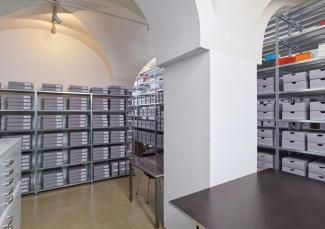
Steirischer Herbst
Useful disruption and productive conflict have always been part of steirischer herbst—an institution that has sparked dialogue time and again throughout its history. Every autumn since its founding half a century ago, the festival has provided a platform for new productions, provoking and shaping public debates in a variety of forms across disciplines and media. Reinventing itself many times over, steirischer herbst has always redefined the terms of the conversation about what culture might mean in a changing contemporaneity, as seen in Graz, Austria’s second most populous city.
steirischer herbst was founded in the pivotal year of 1968, in opposition to the resurgence of nationalist cultural initiatives gaining traction at the time. This founding moment drew upon a tradition of international modernism in music, theater, and visual art—which the Nazis had labeled “degenerate” three decades before—and the belief that it could (still) provide a bulwark against the deep-seated remnants of the totalitarian mentality in the world. steirischer herbst would appear on the scene with the unexpected force of an earthquake, cutting across the wholesome idea of a cultural “autumn harvest” in a region very proud of its wine and fruit. It would enchant, confound, and shock audiences out of their complacency, in the seemingly placid former retirement capital of the Hapsburg monarchy.
Indeed, part of what has made steirischer herbst unique over the course of its history is its engagement with Styria and the city of Graz. The festival emerged through the initiative of the local scenes and continues to play an important role in establishing networks to this day. It has also regularly featured work that delves into Graz’s uneven present and its complex, sometimes troubling past. Activating many if not most of the city’s cultural spaces, the festival rendered the city and the region legible as a text, with new chapters appearing every year.
From its very beginnings, steirischer herbst stood out as one of the world’s few interdisciplinary art festivals, long before the fashionable overuse of the term. Fostering dialogue between the arts by combining aesthetic positions with theoretical reflection, the festival’s various iterations have integrated visual art, music, art in public space, theater, performance, new media, literature, and everything in between, with an emphasis on one field or the other varying over the years. This point remains central to the festival’s approach today, as it emphasizes work that refuses to be bound by the rules and traditional scope of separate cultural fields.
Under the directorship of Ekaterina Degot, who has been heading the festival since 2018, the festival continues in the collaborative spirit of its founding and stays true to its focus on international breadth and local depth. It seeks to foster long-term engagement and the production of new work based on in-depth research and emphasizes urban and regional narratives in their sometimes bizarre relation to global processes. Its central projects can be read as one big exhibition—a single parcours—its elements time- and site-specific, presenting a new way to inhabit social spaces and be engrossed in the stories they might tell.
A strong focus on the social and political urgencies in Austria goes hand in hand with an international orientation. An integral part of the festival in its early years was the so-called Trigon Biennial, named after the polygon-shaped tri-national border of Austria, Italy, and former Yugoslavia. Now, once again, as inequality and nationalism spread both in Eastern and Western Europe, it seems crucial to rekindle this interest in the search for points of connection and solidarity. It is precisely the feeling of marginality, sometimes poignant, sometimes cozy, as experienced in Styria that fosters a sensitivity to other frontier regions, where the purported normalcy of the global order appears in all its surreality and weirdness on the fringes.
steirischer herbst pursues a critical agenda and supports practices that are engaged and engaging. That does not mean that the festival is simply a platform for alternative politics. Instead, it aims each year anew to turn the city into a stage upon which art’s unique imaginative potential—its capacity to tell wild stories and shift shapes, to make impossible conjectures and poetic jokes, to take over spaces and occupy the imagination—is on full view.
Since 1968, steirischer herbst has been setting standards in contemporary art and curating. Following the launch of a research residency program in 2021, the steirischer herbst Research Residency Fellowship 2023 continues to make the festival’s archival resources accessible as part of its mission to place its history in dialogue with contemporary artistic and academic practice. The fellowship supports and encourages innovative scholarly, creative, and interdisciplinary inquiries into steirischer herbst’s practice and history.
The archive includes a press archive, a media archive with over 1,300 items, a file archive, and a reference library holding over 3,000 publications from the 1960s to the present. The majority of items are not digitized and in German.
Due to the festival’s extensive history and interdisciplinary character, the archive provides insight into a wide range of topics:
- cultural politics of Postwar Austria
- art and politics in Austria and Central Europe from the 1960s to today
- art in public space
- politics of media and technology in art
- history of contemporary curating in the visual arts, performance, and theater
Research proposals should address one of these topics.
Fellows are required to produce a work for presentation in the festival’s spaces and on its website. It can take the form of a text, image, audio, or video work (or a combination thereof) that offers insights into their initial findings and/or the direction of their research.


